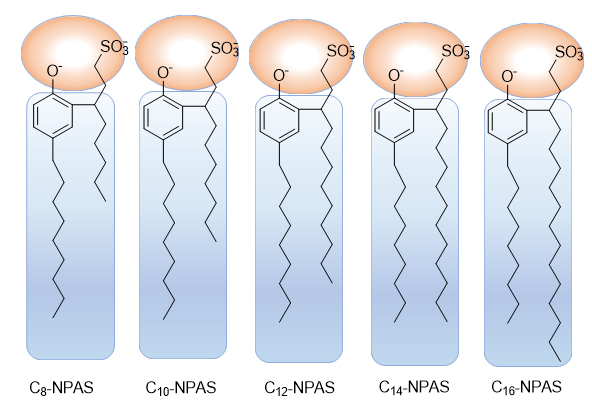摘要/Abstract

采用全原子分子动力学模拟方法研究了壬基酚取代的系列烷基磺酸盐表面活性剂在癸烷/水界面的微观聚集行为,通过分析界面厚度、界面生成能和界面张力以及表面活性剂分子与水分子之间的径向分布函数和配位数,讨论了不同磺烷基链长度对壬基酚基取代烷基磺酸盐表面活性剂界面性质的影响.结果表明,磺烷基链长为12时,表面活性剂的界面张力最低,界面厚度和界面生成能最大.
关键词: 壬基酚取代烷基磺酸盐, 分子动力学, 界面性质, 油水界面, 聚集行为
Anionic surfactants play a key role in many industrial fields such as drug delivery, detergent, oil displacement and food processing because of their unique amphiphilic properties. The structure of surfactant in oil-water system has a great influence on the interfacial behavior. It is of great significance to study the structure and interfacial properties of surfactants. In this paper, the all-atomic molecular dynamics method was used to study the aggregation behavior of nonylphenol-substituted series of alkyl sulfonate surfactants (Cn-NPAS) at the decane/water interface. The effects of different sulfoalkyl chain lengths on the interfacial properties of nonylphenol-substituted alkyl sulfonate surfactants were investigated by analyzing the interface thickness, interface formation energy, interfacial tension, the radial distribution function and coordination number. Simulation results have shown that the interfacial thickness increases at first and then decreases as the length of sulfoalkyl chain increases. The same trend was found in the results of the interface formation energy (IFE). The absolute value of IFE follows the order of C12-NPAS > C14-NPAS > C10-NPAS > C16-NPAS > C8-NPAS, indicating that the C12-NPAS is the most stable system in terms of energy which should be attribute to the stronger aggregation ability. Moreover, it is observed that the trend of interfacial tension is in agreement with that of interface formation energy and the interface thickness. Surfactant C12-NPAS induces the minimum interfacial tension. The calculation results are consistent with the experimental data. Furthermore, the radial distribution function and the coordination number of water around the surfactant headgroup were obtained for evaluating the interaction strength between the hydrophilic headgroup and water molecules. The results are well in accordance with the trend of the interface formation energy and interfacial tension. This indicates that the length of alkyl tail affect the interaction between hydrophilic headgroup and water indirectly. Simulation results suggest that the length of alkyl tail plays a dominant role in the interfacial behaviors. We expect that the results of this study could be valuable for the understanding of mechanism and the design of high performance surfactants.
Key words: nonylphenol substituted alkyl sulfonate, molecular dynamics, interface property, oil-water interface, aggregation behavior
PDF全文下载地址:
点我下载PDF
